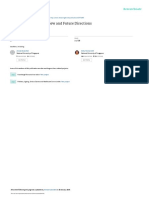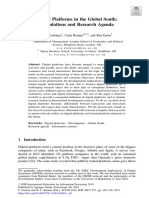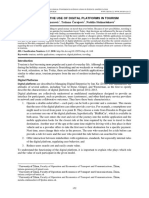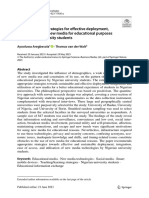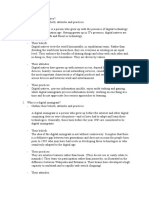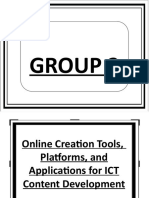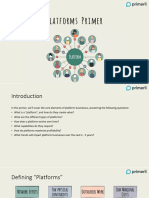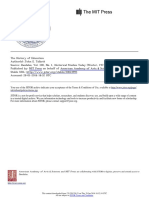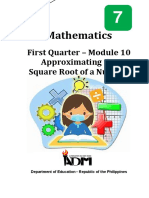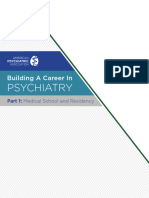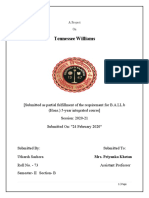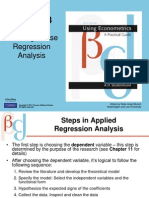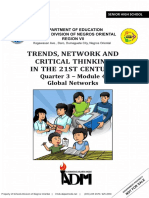th ISSN 2344-0937
11 International Conference of
ISSN-L 2344-0937
Management and Industrial Engineering Volume 11
Website: https://icmie-faima-upb.ro
2023, Bucharest
STUDY ON THE USE OF DIGITAL PLATFORMS
Raluca-Georgiana ION (POPA)1, Georgian ANDREI2, Ștefania-Maria ARMĂȘELU3
1,2,3
National University of Science and Technology POLITEHNICA, Bucharest, Romania
1
ORCID: https://orcid.org/0009-0004-3683-9032
Email : ralucageorgianapopa@gmail.com
2
ORCID: https://orcid.org/0009-0009-6399-3728
Email: andrei.georgiann@gmail.com
3
ORCID : https://orcid.org/0009-0002-8348-7493
Email: stefania.armaselu@gmail.com
Abstract: The explosive technological evolution of recent years has allowed not only the considerable reduction in the
size of storage and data management devices, but also the ever-higher performance of these devices, and their ever-
wider availability, so very easy access to ever-higher performance. The situation has enormous advantages, obviously,
but it also requires precautions or at least rules for using and/or accessing the applications offered by this
unprecedented advance in technology. This article presents a study on the use of platforms to determine what are the
main reasons why people use platforms and what are the problems encountered, and possible solutions to solve these
problems or to reduce their effects.
Keywords: digital platform, consumer behavior, internet, information, problems with digital platforms.
INTRODUCTION
In the contemporary digital era, platforms have emerged as pivotal elements shaping global connectivity, business
transactions, and societal interactions. The transformative influence of digital platforms on our daily lives is evident in
their impact on communication, commerce, and entertainment. Despite their pervasive presence, a nuanced
understanding of the challenges and advantages associated with these platforms is crucial. To address this gap, this
study delves into the multifaceted landscape of digital platforms. Using the Google Trends search engine as a reference,
a public service that shows how often a certain term is searched in several countries, the author observed the graph of
the evolution of interest over time on "digital platform", over the past 5 years, until the present. Beyond mere
observation, the study seeks to contribute to the existing body of knowledge by formulating a well-defined research
question and aligning the investigation with the current state-of-the-art literature.
Figure 1: The evolution of interest in digital platform from 2018 to the present
(Adapted from https://trends.google.com/trends/)
STUDY ABOUT THE USE OF DIGITAL PLATFORMS
123
�Platforms are essentially online spaces or systems that facilitate the exchange of information, goods, and services. They
provide a virtual environment where users can create, share, and consume content, engage with others, and access a
wide range of resources. The popularity and widespread use of platforms can be attributed to several key factors [7].
First and foremost, connectivity is a major driver. Platforms such as Facebook, Twitter, and Instagram have redefined
how people from different parts of the world can instantly connect and communicate [1]. These social media platforms
have transformed the way we interact, allowing us to maintain relationships, express opinions, and stay updated on
current events.
Accessibility is another crucial factor. Platforms have made information and resources more accessible than ever before.
Search engines like Google and Bing provide instant access to a vast amount of knowledge. Educational platforms like
Coursera and Khan Academy offer online courses and learning materials. E-commerce platforms such as Amazon and
Alibaba have revolutionized shopping, making it possible to browse and purchase products from the comfort of our
homes [2].
Economic opportunities have also expanded significantly due to platforms. Services like Airbnb and Uber have created
opportunities for individuals to monetize their assets, such as renting out spare rooms or providing transportation
services. Online marketplaces like Etsy and eBay enable individuals to sell handmade crafts and vintage items to a
global customer base [2].
In the realm of entertainment and content consumption, platforms have had a profound impact. Streaming platforms like
Netflix and YouTube offer a wide array of movies, TV shows, and videos, allowing users to personalize their
entertainment preferences. Platforms like Spotify and Apple Music have revolutionized the music industry by providing
convenient access to a vast library of songs and podcasts [3].
Methodology
This study employs a robust methodological approach to unravel the complexities of digital platforms. To conduct the
proposed study, the authors employed various research methods, commencing with the selection of the research topic
and the motivation behind this choice, leading to a thorough analysis of the subject matter [6]. These chosen methods
encompassed the exploration of the issue through materials provided by various authoritative institutions and a review
of specialized papers related to the topic of interest, culminating in the extraction of valuable information [3].
By framing the research variables and questions explicitly, the study enhances its clarity and focus. To navigate the
complex terrain of digital platforms systematically, this study identifies key research variables and articulates
corresponding research questions:
User Satisfaction: Assessing users' satisfaction with digital platform content and services.
Time Spent: Investigating the time users allocate to find information and comprehend platform content.
Information Quality: Evaluating the perceived quality of information accessed on digital platforms.
The survey aspect of the study adopts a strategic approach, employing a semi-structured questionnaire distributed
through Google Forms. With a deliberate focus on the local community, the survey captures perspectives on digital
platform usage primarily in Romania. The choice of virtual platforms for survey distribution, including Facebook,
WhatsApp, and email, is justified by their widespread usage in the target demographic. The survey was conducted in
Romania, primarily through virtual platforms such as Facebook, WhatsApp, and email, during the months of May and
June. To ensure the reliability of the findings, a sample of 101 individuals aged between 18 and 60 years participated in
the survey. Subsequently, the collected data were processed and analyzed using the analytical capabilities embedded in
Google Forms, including the generation of graphical representations. These visualizations provide a clear and concise
representation of the survey findings, enhancing the accessibility and interpretability of the results.
Results and discussions
The demographic profile of the respondents resulted in being composed of 68.3% of women, 31.7% of them aged
between 18-60 years, and 57.4% of people living in urban areas. A percentage of 67.3% have completed higher
education, while 27.7% have pursued only secondary education, equivalent to high school, and a percentage of 5% have
only elemental studies.
Given that the global count of internet users expanded by 171 million over the last 12 months, equating to an average of
nearly half a million new users each day, and considering that the typical worldwide internet user now dedicates 6 hours
and 37 minutes to online activities daily, it is unsurprising that the enthusiasm for engaging with social media platforms
has also surged [4].
Figure 2 represents the second inquiry in the survey pertained to the identification of the most frequently accessed
online platforms. Upon collating the responses, the findings revealed that social media platforms ranked as the
predominant choice, garnering the preference of a majority, specifically 57 respondents. Subsequently, e-learning
platforms were identified as the second most frequented, selected by 47.5% of the respondents. Information-oriented
platforms received 36 responses, while e-commerce platforms received 32. Testing platforms garnered 14 responses,
and streaming platforms registered the lowest preference, with only 10.9% of respondents opting for them.
124
�Figure 2: The most accessed platforms
The coronavirus pandemic has exerted a substantial influence on the amount of time people spend online. It has
stimulated the necessity to establish connections through various means, as well as to seek solace and entertainment via
social media platforms. The repercussions of these behavioral shifts can still be observed in the present moment [5]. In
Figure 3, the authors see that the main reason why the respondents accessed the platforms was to participate in courses
(34.7%), followed by online shopping with 25 answers (24.8%), a very close percentage to finding out some
information (23.8%). Other answers were: the posting of course materials and tests, entertainment, or some respondents
said that they accessed platforms for all the listed reasons.
Figure 3: Motivation for accessing digital platforms
In Figure 4, most of the respondents found the information they needed in 5-10 minutes (26.7%) followed by the variant
with less than 5 minutes, with 23 answers. In a tie for third place were the search time 10-20 minutes and 30-60
minutes, each with 18 responses (17.8%), followed by the 20-30 minutes variant which accumulated 13 responses. Only
2% of the respondents spent more than 60 minutes looking for what they needed. The average time in which the
respondents found the information they needed was 18 minutes, which leads us to the conclusion that the information
should be better structured to be easy to identify.
125
�Figure 4: Time spent to find information
Figure 5 illustrates the extent of time respondents required to grasp the information they sought from the platform. The
data reveals that the majority of respondents, comprising 32.7%, indicated a need for less than 5 minutes to comprehend
the content. Approximately 26.7% of respondents fell within the 5-10 minutes bracket, while 14.9% reported requiring
10-20 minutes. Furthermore, 11.9% of respondents each mentioned needing 20-30 minutes and 30-60 minutes,
respectively. Only 2 respondents stated a necessity for more than 60 minutes to understand the information. The average
time for respondents to grasp the desired information from the platform was 15 minutes. These findings emphasize the
importance of presenting platform content in an easily comprehensible manner.
Figure 5: Time needed to understand the information
Respondents rated the information quality on a scale of 1 to 5, with 1 being very dissatisfied and 5 very satisfied (Figure
6). Notably, 50.5% expressed satisfaction, while 31.7% were very satisfied. An additional 8.9% remained neutral, 6.9%
were dissatisfied, and 2% were very dissatisfied. The average score, 4.02, suggests overall satisfaction. This signifies
that the majority of respondents were content with the information they accessed. To enhance information quality
further, measures should include rigorous fact-checking and improved structural clarity to ensure ease of
comprehension.
Figure 6: Satisfaction regarding the quality of information
Respondents were asked to rate their satisfaction with various aspects of their platform experience on a scale from 1 to
5, with 1 being very dissatisfied and 5 very satisfied, results are illustrated in figure 7.
Regarding the time spent on the platform to find the needed information, 45 respondents expressed satisfaction, 16 were
neutral, 15 were very satisfied, 13 were dissatisfied, and 12 were much more dissatisfied, resulting in an average score
of 3.37. This indicates that respondents were not entirely content with the time spent, suggesting a need for more
efficient information presentation.
In terms of the relevance of the information, 42 respondents were satisfied, 18 were very satisfied, 18 were neutral, 12
were very dissatisfied, and 11 were dissatisfied. The average score was 3.42, signifying room for improvement in
information structuring to enhance clarity and accessibility.
Regarding the structure and ease of understanding of the information, 36 respondents were satisfied, 21 were very
satisfied, 20 were neutral, and 12 respondents expressed dissatisfaction. The average rating was 3.41, suggesting that
information structuring could benefit from highlighting key concepts for better comprehension.
126
�Figure 7: Satisfaction regarding the information
In the subsequent section of the questionnaire, respondents were asked to indicate their level of agreement with a series
of statements on a scale ranging from 1 (indicating total disagreement) to 5 (indicating total agreement). The results for
the factors mentioned are illustrated in Figures 8 through 12.
The first statement was about the fact that the platform is suitable for the needs of the respondents, 40 partially agreed
with the statement, 26 said they strongly agreed with the statement, 17 respondents chose partially to disagree, 14 were
neutral and 4 chose strongly to disagree. The average of the responses was 3.66 which means that there could be
improvements for each need.
In terms of the need for socialization and relaxation, the average was 3.67 which means that people partially agree with
what they find on social networks and the content should be improved by applying filters for each person's needs.
The next identified need was the learning need which had an average of 4.06, a higher average than the first which
means that the respondents were more satisfied with the content found on the e-learning platforms, but also that it can
become better through improving the quality of learning materials.
Another need identified was the need for information which had an average of 3.83 and regarding this aspect, the
structuring of the information and its quality should be improved to make it easier to understand for each person.
The need to buy obtained an average of 3.93 from which we can deduce that people are generally satisfied with what
they find on e-commerce sites but that there could be improvements here too regarding the way products are placed,
their description, and all the details displayed.
In terms of information, there was an average of 3.42, being the lowest value among all those identified. Here the
content of the tests should be improved so that the questions are easy to understand, if there are answer options, they
should be as simple as possible and there should not be a very high degree of difficulty for the respondents.
The second statement referred to the interface of the platform, if they find it intuitive and 37 respondents partially
agreed with the information, 28 fully agreed, 22 neutral, 8 partially disagreed and 6 totally disagreed. The average being
3.72 we can say that there are platforms that are easy to use but that they could be improved and become suggestive for
those who access them.
127
�Figure 8: Respondents opinion over the utility of the platform
The third statement addressed the organization of the platform: "The platform's functions are logically organized in
menus." Among respondents, 41 partially agreed, 27 fully agreed, 15 were neutral, 14 partially disagreed, and 4
strongly disagreed. The average response was 3.72, indicating potential for improving menu organization to make it
more intuitive and comprehensible for the majority of users.
The fourth statement focused on synchronous communication on the platform. It was observed that 37 respondents
partially agreed, 28 fully agreed, 20 were neutral, 12 partially disagreed, and 4 strongly disagreed. The average score
was 3.72, suggesting room for improvement in synchronous communication. One way to enhance this aspect could be
by employing specialized personnel to provide real-time responses to platform users.
Figure 9: Respondents opinion over platform functions
The subsequent statement pertained to the modes of asynchronous communication provided by the platform. It was
found that 42 respondents partially agreed, 22 were neutral, 17 fully agreed, 14 partially disagreed, and 6 strongly
disagreed. With an average score of 3.49, lower than that of synchronous communication, it suggests potential issues in
message comprehension and extended waiting times, highlighting the need for improvements in these areas.
Another statement focused on the ease of selecting items from the platform menu. Among respondents, 37 partially
agreed, 35 fully agreed, 16 were neutral, 10 partially disagreed, and 3 strongly disagreed. With an average score of 3.90,
it is evident that menus should be made more intuitive to facilitate users in navigating the platform effectively.
Figure 10: Respondents opinion over platform usability
In the context of this scientific study, an observation was made regarding the potential incorporation of a rapid search
feature within the platform's interface. Among the surveyed participants, 36 individuals expressed strong agreement
with this proposition, while 29 leaned towards partial agreement, 22 maintained a neutral stance, 9 tended towards
partial disagreement, and 5 expressed complete disagreement. The calculated average rating of 3.81 indicates a clear
consensus among respondents, affirming the perceived utility of implementing a keyword-based search functionality in
the platform, thereby facilitating easy access to desired information.
128
�In relation to the overarching assessment of the platform's user-friendliness, 39 respondents indicated partial agreement,
while 35 respondents fully concurred with the statement. Additionally, 16 participants remained neutral, 7 opted for
partial disagreement, and 4 registered complete disagreement. With an average rating of 3.93, it is evident that there
exists room for enhancement to ensure the platform's accessibility to most users, a goal that could be realized through
intuitive platform design.
Figure 11: Respondents opinion over the user experience offered by the platform
Regarding the ease of comprehending the platform's operational procedures, the responses were as follows: 39
participants expressed partial agreement, 34 respondents fully concurred, 13 maintained a neutral stance, 10 leaned
towards partial disagreement, and 5 expressed complete disagreement. The calculated average score of 3.86 indicates a
notable consensus that suggests room for enhancing the platform's structure to ensure broader accessibility.
In the context of data protection, 34 respondents partially agreed that their data is safeguarded, while 33 fully agreed.
Meanwhile, 22 respondents remained neutral, 8 leaned towards partial disagreement, and 4 registered complete
disagreement. With an average response rating of 3.83, it is evident that there is still some uncertainty among users
regarding the security of their data. Information dissemination to clarify and assure users about data protection measures
could prove beneficial in addressing these concerns.
Figure 12: Agreement over working experience with a platform
When asked about the difficulties or problems encountered while using a platform, respondents provided a range of
issues they've faced. Interestingly, some participants reported encountering no difficulties while using the platform,
suggesting that a seamless user experience is indeed achievable. However, a noteworthy aspect of the feedback was the
presence of SPAM and intrusive advertisements, which underscore the necessity of implementing effective content
moderation and advertising management to preserve a user-friendly environment.
The expressed desire for a mobile version of the platform serves as a reminder of the growing importance of mobile
accessibility in today's digital landscape. Furthermore, challenges such as difficulty in finding specific information due
to search engine limitations highlight the critical importance of maintaining robust search functionality and information
retrieval systems to facilitate user interactions.
Issues like slow loading times and congestion should not be overlooked, as they underline the need for continuous
optimization of platform performance to mitigate user frustration effectively. Addressing non-intuitive interface design
and hidden buttons becomes paramount to enhance user navigation and ensure an intuitive overall user experience.
129
�Reports of receiving only partial information further emphasize the need for platforms to prioritize providing
comprehensive and relevant content, aligning their offerings more closely with users' specific needs. Lastly, the
challenges related to logging in, platform access, and extended waiting times underscore the significance of
streamlining user authentication processes and reducing wait times to enhance overall user satisfaction.
CONCLUSIONS
Nevertheless, it is of utmost importance to acknowledge that while platforms offer a plethora of advantages, they also
bring forth a multitude of intricate challenges and considerations. Concerns pertaining to data privacy, online security,
algorithmic biases, and the consolidation of power within a limited number of dominant platforms necessitate thorough
examination and the implementation of effective regulatory measures.
The research paper successfully attained its proposed objectives, successfully identifying, analyzing, and extracting
essential information. In summary, platforms have unquestionably evolved into an integral aspect of contemporary
society, fundamentally reshaping the way we connect, communicate, and engage with the world. Findings from the
survey underscore the centrality of social media platforms, with most respondents favoring them over other online
platforms. The impact of the COVID-19 pandemic on online behavior is evident, emphasizing the need for platforms to
adapt to changing user motivations.
The motivations for accessing digital platforms, as illustrated in Figure 3, highlight a diverse range of user needs. It is
noteworthy that respondents primarily accessed platforms for educational purposes, emphasizing the evolving role of
platforms in facilitating learning.
The time-related figures (Figures 4 and 5) shed light on the efficiency of information retrieval and comprehension.
Users generally spend a moderate amount of time finding and understanding information, emphasizing the importance
of well-structured content for ease of access.
User satisfaction, as gauged in Figure 6, indicates a generally positive sentiment regarding information quality.
However, specific aspects, such as time spent on the platform and the structure of information, reveal areas for
improvement. The authors may choose to extend this study by enhancing the level of trustworthiness through the
expansion of the respondent pool, encompassing a broader range of age groups and occupational backgrounds. This
expansion would contribute to a more comprehensive understanding of the subject matter, potentially yielding deeper
insights into the complexities surrounding platform usage and its implications.
REFERENCES
[1] Benchmarking - analiză şi competivitate. Available from:
https://vdocuments.mx/bench‐marking‐analizasicompetitivitate.html.
[2] Brennan, J., & Shah, T. (2000). Managing Quality in Higher Education.Buckingham: Open University Press
[3] Meyer, J. P., & Zhu, S. (2013). Fair and equitable measurement of student learning in MOOCs: An
introduction to item response theory, scale linking, and score equating. Research & Practice in Assessment, 8,
26–39, https://eric.ed.gov/?id=EJ1062822 [Accessed 2023-08-13]
[4] Moosbrugger, H., & Kelava, A. (2012). Testtheorie und Fragebogenkonstruktion. In Statistik für Human- und
Sozialwissenschaftler (pp. 7–26). Berlin, Heidelberg: Springer, http://doi.org/10.1007/978-3-642-20072-4_2,
[Accessed 2023-08-13]
[5] Oppl S., Reisinger F., Eckmaier A. & Helm C. (2017), A flexible online platform for computerized adaptive
testing, International Journal of Educational Technology in Higher Education 2017 / 12 Vol. 14; Iss. 1,
https://www.redalyc.org/pdf/5015/501550295008.pdf, [Accessed 2023-08-17]
[6] Kröhne, U., & Frey, A. (2011). Multidimensional Adaptive Testing Environment (MATE)–Software for the
Implementation of Computerized Adaptive Tests. Presented at the International Conference on Computerized
Adaptive Testing, Pacific Grove, CA, USA, https://www.ncbi.nlm.nih.gov/pmc/articles/PMC5978497/,
[Accessed 2023-08-19]
[7] Veldkamp, B. P., & Matteucci, M. (2013). Bayesian computerized adaptive testing. Ensaio: Avaliação e
Políticas Públicas em Educação, 21(78), 57–82. http://doi.org/10.1590/S0104-40362013005000001, [Accessed
2023-08-21]
Corespponding author:
Ion-Popa Raluca Georgiana
Email address: ralucageorgianapopa@gmail.com
130


